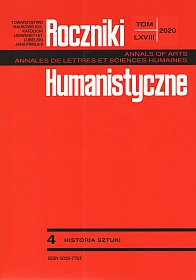Szlachetna amatorka. Akwaforty Anetki Tyszkiewiczówny z albumu Vues de Pologne
A noble amateur. The etchings by Anetka Tyszkiewiczówna from the album Vues de Pologne
Author(s): Ryszard MączyńskiSubject(s): Fine Arts / Performing Arts, Visual Arts, History of Art
Published by: Towarzystwo Naukowe KUL & Katolicki Uniwersytet Lubelski Jana Pawła II
Keywords: drawing; etching; landscape; veduta; amateur artist; Anna (Anetka) Potocka-Wąsowiczowa née Tyszkiewicz; Ignace Duvivier; Polish art at the turn of the 18th and 19th centuries
Summary/Abstract: The article is devoted to the etchings collected in the album Vues de Pologne, dedicated to Anna (Anetka) Tyszkiewiczówna (1779-1867). Throughout her life, she was involved in amateur artistic work: drawing, painting and, above all, design, which left its mark on the palace and garden layouts in Wilanów, Natolin, Mokotów, Jabłonna and Zator. The album was created as a result and as a memoir of her stay in Vienna in 1795. At that time she took drawing and etching lessons from the French painter Ignace Duvivier (1758-1832) – an artist that was later accepted as a member of the local academy. Apart from the title page, in its basic version the album contains nine views mainly of Warsaw and its surroundings. Tyszkiewiczówna was the author of all the drawing patterns, she also transferred them onto the printing plates. In these works she clearly preferred landscape motifs over vedutas. She tried to reflect the mood of the moment through a lively, energetic line and strong value contrasts. She composed sentimental, subjective landscapes with little care for accuracy or realism in the representation of reality. It is also possible that the latter feature was intensified by the recreation of patterns from her memory, in Vienna, far away from the portrayed places. Evaluating the artistic value of her works—in terms of the technique used they do not differ at all from the works of her teacher—one should remember that they are juvenile works since the author was only sixteen at that time. Her plates were reused at the beginning of the 19th century for commercial purposes – six out of nine etchings adorned the 1811 edition of “The Political, Chronological and Historical Calendar”, printed by Jan Ludwik Koch. On the basis of the considerable number of prints in collectors’ circulation—those from 1795 as well as those from 1811—it is possible to conclude that this part of her work is exceptionally popular for an amateur. But after this youthful experience, Anna née Tyszkiewicz, primo voto Potocka, secundo voto Dunin-Wąsowiczowa, never returned to the etching technique.
Journal: Roczniki Humanistyczne
- Issue Year: 68/2020
- Issue No: 4
- Page Range: 39-78
- Page Count: 40
- Language: Polish

